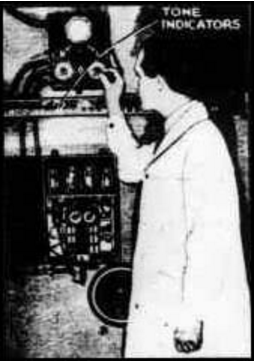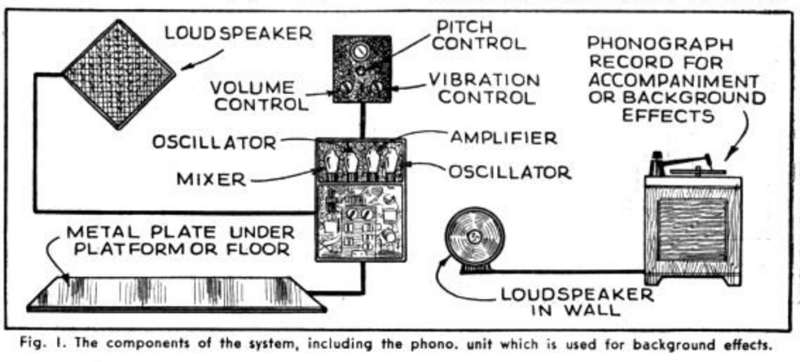Léon Theremin built his eponymous instrument in 1920 under Soviet sponsorship to study proximity sensors. He later applied the idea of generating sounds using the human body’s capacitance to other physical forms like the theremin cello and the theremin keyboard. One of these was the terpsitone, which is kind of like a full-body theremin. It was built about twelve years after the theremin and named after Terpsichore, one of the nine muses of dance and chorus from Greek mythology.

Instead of waving one’s hands near loops or rods, the terpsitone was played by dancing atop a large steel plate. As the dancer bends down toward the plate, capacitance increases and the resulting pitch decreases. Raising up away from the plate has the opposite effect; capacitance plummets and the pitch increases. As with a theremin, the oscillator being controlled by the dancer beats against a fixed oscillator. The output is amplified and sent to a loudspeaker.
A built-in light show set the terpsitone apart from the other theremin-esque instruments. For each pitch sounded by the dancer’s movements, a corresponding colored glass lamp would illuminate. Each light was driven by a reed that vibrated sympathetically with a certain pitch, closing the switch and lighting the lamp.
The terpsitone was even more difficult to control than the theremin. In the short video after the break, the player makes do by crouching on the plate and controlling the pitch with his arm and fingers. Unfortunately, only three terpsitones were ever built. The last one was built in 1978-79 for acclaimed theremin player Lydia Kavina, who happens to be Léon Theremin’s grandniece. This is the only surviving instrument, although the spirit of gesture-controlled musical composition lives on in wearable instruments and console games like Wii Music.
Retrotechtacular is a column featuring hacks, technology, and kitsch from ages of yore. Help keep it fresh by sending in your ideas for future installments.















The thing about these types of instruments was that they were very, very hard to play well and more than anything else limited their popularity and further development
Just like a holophoner.
I can’t see what the fascination is with them apart from been able to make some weird sounds. To call the theramin a musical instrument is akin to calling a kaleidoscope a television.
You can play classical music on a Theremin. Or more accurately, about 2 people in the world can play classical music on a Theremin. It’s difficult. That’s part of the charm for some people. Requires a huge amount of skill, but can be very expressive, since the smallest movement can affect the sound.
wanted to echo Saabman. The theremin in proper hands is almost everything the modern synthesizer has become. It can generate sounds resembling almost any instrument, nearly simulate voices, all sorts of thing. Kavina has demonstrated this capability on a few documentaries and it is amazing to those who thought all it did was make “spaaace” noises.
The terpsitone was also demonstrated to be able actually play music but again, the full body precision physical control and discipline needed was something most music makers would never desire to train for, and those with the physical skills in dance and form aren’t terribly interested in electronic music.
Plus everyone was pretty much stuck in “spaaace noises from beyond the moon” mindset
There are people who can play theremin – for example https://www.youtube.com/watch?v=KXuB62SMFvA or https://www.youtube.com/watch?v=48KSz2V41x4
Unfortunately, self proclaimed “theremin builders” – with absolutely no musical ear and taste – , who confuse the real theremin with some 555 controlled beepers are doing bad service for the real theremin. So as we can see, a lot of people still think that theremin can be used only to generate weird noises,
Every musical instrument requires a years of dedication and training, when somebody hits the piano keyboard and produces disharmonic clash, does it mean that piano is good for noises? On the other hand, there is only a handful of real masters, like Kissin, Sokolov or Argerich (to name a few living masters, you may have other favorites).
Well weird sounds can be made with any musical instrument, and that doesn’t make them any less of a musical instrument. In the end it’s all about creating sound that many desire to listen to often. That’s where the Theremin & Theremin players come up short. IMO.
I guess I need to get a video of me playing slide steel with built in e-bow type sustain. There is something on my YouTube channel, search it out I will add more. Hard to play, why it’s just like singing. Look at the string sections of an orchestra. See any marks or frets? I had my hands (not) on an Moog Etherwave once, about 10 years ago. I didn’t know what I do now, I could add to that world count.
It’s all about muscle memory and listening, same as singing. Having your hand on something is better than nothing at all. Remaining as still as a store manikin to wave at antennae is harder for sure. I don’t understand the cramp inducing posture at all for the video. Wouldn’t it be easier to stand up with bare or socked feet? Good pitch, no audio for us (-23dB) according to Audacity. That’s less than one hundredth of the level that should be on the video, eeeggghhhh!
I would like to hear him dance a jig!
“Look at the string sections of an orchestra. See any marks or frets? ”
The difference to a string instrument is that the “tuning” of a theremin changes constantly. You can’t even form a muscle memory of where the notes are, because a gust of cold through a window changes the dielectric constant of air.
The theremin is also inherently a whole body instrument. The way you stand makes a difference, the kind of shoes you wear makes a difference, whether you’ve shaven your beard makes a difference. It’s just constantly in flux and you have to re-adjust on the fly, which makes the characteristic off-tune drunken goose-chase playing style.
It’s also why most players tend to over-emphasis the vibrato and use very slow transitions between notes as if playing a saw – to mask the errors and to hear where they’re going.
I carefully read the therminovox article and gathered it produced tones from a bank of chromatic tuned reed relays excited from the actual capacitance bugged VFO fed into them.They also ran different colored lights for each note! So it would have been like a keyboard in a digital sense. Monophonic. They played it with recorded accompaniment.
I have heard ‘duino type theremins that seem to have this feature. I like to be able to slide and inflect and do a really human vibrato.
This had no volume control at all, once the dancer only operated it.